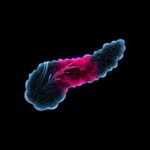What is already known
Sulfated glycans are nutrient sources for gut microbes, which metabolize them using enzymes called carbohydrate sulfatases. However, little is understood about how carbohydrate sulfatases recognize their glycan substrates.
What this research adds
To understand how sulfatases from gut microbes recognize sulfated glycans, researchers determined the structure of seven carbohydrate sulfatases from four sulfatase subfamilies. Some of the structures are novel and showed that non-conserved protein regions confer each enzymes specificity toward distinct glycans.
Conclusions
The results reveal that carbohydrate sulfatases are highly selective for their specific glycan substrates — a finding that could help researchers to understand the roles that these enzymes play in the breakdown of host glycans.
Sulfated glycans are molecules found in many species — from plants to humans, and they play key roles in the biology of the cell. They’re also important nutrient sources for microbes. New research now offers insights into how human gut bacteria recognize sulfated glycans.
The results, published in Nature Chemical Biology, reveal that carbohydrate sulfatases are highly selective for their specific glycan substrates — a finding that could help researchers to understand the roles that these enzymes play in the breakdown of host glycans.
Understanding the structure of carbohydrate sulfatases could also help to develop interventions for diseases where sulfated glycan metabolism is altered, the researchers say.
Gut microbes metabolize sulfated glycans using enzymes called carbohydrate sulfatases. However, little is understood about how carbohydrate sulfatases recognize their glycan substrates. “Only 14 unique carbohydrate sulfatase structures have been described, and only eight of these have been reported in complex with a ligand,” the researchers say. These proteins, they add, are among some the most poorly characterized enzymes to date.
So, Alan Cartmell at the University of Liverpool, Ana Luis at the University of Gothenburg and the University of Michigan and their colleagues set out to resolve the structure of carbohydrate sulfatases of the S1 family. About 90% of all known carbohydrate sulfatases belong to the S1 family.
Solving structures
The sulfatases were expressed by Bacteroidetes bacteria, which are common in both the human gut microbiota and marine environments.
The researchers used a structural biology technique called crystallography to determine the structures of seven Bacteroides carbohydrate sulfatases from four S1 subfamilies. By analyzing the diffraction patterns of a sample targeted by a beam of X-rays, crystallography allows researchers to study the arrangement of atoms in crystals.
First, the researchers placed the carbohydrate sulfatases in solution and allowed them to form crystals. Then, they collected data using a beam of radiation.
Target specificity
The team found that S1 sulfatases share many conserved features. However, differences in non-conserved protein regions appeared to confer each enzyme specificity toward distinct glycans.
Within a specific subfamily of S1 sulfatases from the gut bacteria Firmicutes and Bacteroidetes, all of the key protein residues were strongly conserved with the exception of one, which is preserved in Bacteroidetes but is mostly absent in Firmicutes, the researchers found. “These conserved recognition features are also found in several pathobionts as well as a single strain of non-pathogenic C. difficile, which is considered to prevent infection by pathogenic strains,” they say.
“The specificity of S1 carbohydrate sulfatases makes these enzymes excellent targets for small-molecule intervention to modify their function and to develop tools to probe sulfated glycan metabolism, and for disease intervention where sulfated glycan metabolism is perturbed,” the authors say.









